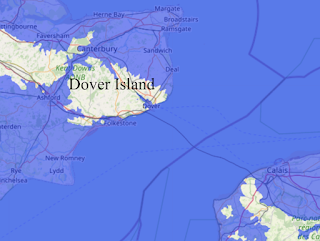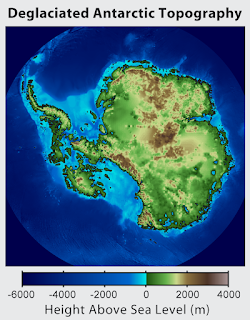While cetaceans in the seas may go extinct, it is not all ceteceans that will die. Though things do not look good for most cetaceans, they will survive in rivers. This is known as ))))
Current river dolphins
Things do not look good for current river dolphins. Human activity seems like it may finish off the boto before too long. A similar fate also happens to the other ones that may exist, except perhaps the one currently in the Indus, which, while endangered, has managed to survive in a river which has been used by humanity since the bronze age, so should be relatively well adapted for water being used for irrigation.
Beluga whales
While current river dolphins may not survive, ripurian beluga whales do. Specifically, the ones in the St. Lawrence river. These belugas manage to get into the great lakes, and from there to the Mississippi river.
Getting to the Mississippi
Now, you might be wondering why there exist no records of whales of any kind in the Mississippi Basin from human times. The answer to this is that previously there were waterfalls in the way. Imagine trying to swim up Niagra Falls. It's pretty impossible. However, there are canals built by humans that the Saint Lawrence beluga population could use. The final streach would be down the Chicago river,
The human desire to create navigable waterways created a way for river whales to arise in the Mississippi. Naturally, parting rivers are rare, but early into the early first period of the Mellogene, the ochetamnicene, canals ended up becoming rivers as the dams and locks erode, with them generally not having waterfalls, although they do sometimes form when the hill is especially steep. This means that rivers start to flow through human-cut channels, allowing dispersal to cross previously impassable waterfalls, in particular those on the Saint Lawrence.
Because concrete erodes quickly, these canals generally quickly became navigable rivers, allowing the beluga to disperse not only into the great lakes, but also into the Hudson river, and far and wide through the plethora of canals that have been dug over the ages, whose locks have since erroded away, creating a system of splitting rivers across the midwest, reminiscent of a poorly drawn fantasy map.
Changes in colour
A white whale in the Mississippi would stick out like a sore thumb in the sediment-choked water. Because the Mississippi is generally brown, a change towards that color would begin. It maybe would start with the species retaining their colouration as calves throughout their whole lives. On the other hand the yellowish color they become in the winter would also help with their camoflage, though the thicker skin could be a cause of over heating.
I would generally guess that the yellowish colouration born from thicker skin in the winter is for purposes of insulation. Thus, in a warming world, it would be much less likely to even retain this trait, and therefore, may lose it before making it to the Mississippi where it would be beneficial, thus preventing its usage as an exaptation. Furthermore, the area where this would be at its most useful is the lower Mississippi where the waters turn khaki, but I predict some sort of protein would develop to turn it khaki to match the waters. The lower Mississippi species I will call Delphinapterus pyxinos.
Diet
These belugas would be mighty successful if they could manage to eat the asian carp that infests the Mississippi watershed. While current species are able to prey on small carp, fully grown carp are a different story, and are an abundant and untapped food source, and while normally I would expect an alligator to eat them, I would think we would see niche partitioning, with Cyprinosuchus and D. pyxinos adopting different feeding strategies. Because Belugas are relatively slow swimmers, the pyxine beluga would probably be sower than the Cyprinosuchi, meaning that Cyprinosuchus would be given the niches of things like persuit predatorss. The pursuit predator Cyprinosuchus podenemos would not directly compete with pyxinos which would allow it to consume carp another way.
In the Great lakes themselves, basically all apex niches would be taken over by descendents of the beluga whales, and they would split into a few groups.
The Filter-Feeding Whale of Lake Superior
In Lake Superior, there is a lot of room, and it likely could support a filter feeder. This evolutionary pathway starts out with Delphinapterus deliquans, which begins by suplementing its diet by filter feeding. Gradually more and more of its diet becomes dominated by filter feeding to the point where, in lake superior, Liquatorium superioranum evolves, the first to fully filter feed, using modified teeth unlike the baleen whales of today. It is isolated to Lake Superior, and is too large to leave. It is hunted by another cetacean, Cetiophagos balingera, occupying a niche of a predator of filter feeders, which megalodon used to have.
Other species of Liquatorium exist, which also eat other things, such as L. phyciophagon, which also eats seaweed. Liquatorium phyciophagon has lips which are slightly more dexterous and allow it to suplement its diet. Later, diverging from this is the much smaller Liquatorium parvum, which fully feeds on duckweed, grazing on them near the surface of the water. Unlike these, Liquatorium piscicapum developped a second set of teath slightly shorter than the first to chew smaller fish caught in its gulps.
L. parvum has diverged into a number of subspecies, L. parvum proprium is the one in lake superior, but there are also L. parvum erieus in Lake Erie, and huronum in Lakes Huron and Michigan. They are all very similar, and mostly differ in ways not worth noting here.
Most species of Liquitorium are prey for C. balingera.
Cyprinosuchus
Cyprinosuchus podenemos is a species descended from the American Alligator. It has reduced legs, and spends most of the time in the water hunting asian carp by chasing them down. Over time, they will spread north into the midwest. The niche of pursuit predator is taken up by a whale in the Great Lakes—Delphinapterus diocticus. However, D. diocticus would be unable to enter the Mississippi via the Chicago River due to it not being particularly maneuverable. On the other hand, the subspecies of C. podenemos of the Chicago river, Cyprinosuchus podenemos sicaquensis, has sacrificed a lot of speed for maneuverability, leaving it outcompeted in Lake Michigan, whereas D. diocticus ilinorum, the subspecies found in Lake Michigan (as opposed to in Lake Huron's D. diocticus eurinus; other lakes have their own somewhat convergently evolved species like D. occursans), is much less maneuverable in tight spaces such as rivers. However, Cyprinosuchus podnemos did make it into Lake Michigan, whose abundant duckweed provided perfect cover for an ambush predatory niche. Due to the fact mammals as a rule cannot make green pigments, a crocodillian would be much better than a whale, although further into the lake this niche is taken by the fish Phycichthys furtivus, among others, one the very shore, C. podnemos chlorus takes advantage of its ability to exit the water to act as an ambush predator in the shallows.
Sources
https://montreal.ctvnews.ca/there-are-now-two-whales-in-montreal-s-st-lawrence-river-1.5898781
https://www.theverge.com/2021/3/23/22346339/video-dolphins-venice-canal-real
https://www.themayor.eu/en/a/view/lisbon-the-only-european-capital-with-wild-dolphins-8761
https://www.huffpost.com/entry/the-unlikely-hero-could-b_b_5607138
https://en.wikipedia.org/wiki/Welland_Canal
https://www.fisheries.noaa.gov/species/beluga-whale
https://en.wikipedia.org/wiki/Geologic_time_scale
https://www.britannica.com/topic/Saint-Lawrence-Seaway/History
https://en.wikipedia.org/wiki/Erie_Canal#Migratory_impact
https://en.wikipedia.org/wiki/Chicago_River#Discharge
https://en.wikipedia.org/wiki/Des_Plaines_River
https://www.coolantarctica.com/Antarctica%20fact%20file/wildlife/Arctic_animals/beluga-whale.php
https://www.canr.msu.edu/news/asian_carp_being_eaten_by_native_fish_new_studies_find
https://www.canr.msu.edu/news/setting_the_record_straight_on_alligator_gar_and_asian_carp_msg16_okeefe16#:~:text=This%20resolution%20specifically%20states%20that,of%20eating%20adult%20Asian%20carp.%E2%80%9D
https://en.wikipedia.org/wiki/American_alligator#Characteristics
https://www.experiencekissimmee.com/blog/7-alligator-facts-you-probably-didnt-know#:~:text=In%20the%20water%2C%20an%20alligator,challenge%20one%20to%20a%20race.
https://www.miamiherald.com/news/nation-world/national/article245624365.html
https://www.world-of-waterfalls.com/interactive-destinations/interactive-north-america/interactive-north-america-usa/


Comments
Post a Comment